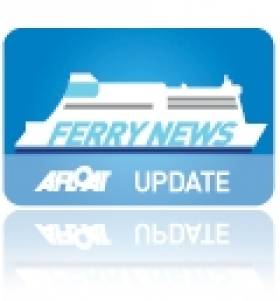Displaying items by tag: Port de Cherbourg
Calling Cherbourg: All Things Nauting
#FERRY SAILS – Ferry passengers perhaps on a mini-wine break cruise between Rosslare-Cherbourg may be taking a detour to the Cherbourg Nauting Boat Show which is been held this weekend, writes Jehan Ashmore.
Both Celtic Link Ferries and Irish Ferries operate on the continental route to the man-made Norman port originally constructed by Napoleon. The present day bustling town-centre of Cherbourg-Octeville to give its full name is close to the large 1500-plus berth marina at the Port Chantereyne which is hosting the show.
Those attending can buy and sell new and second-hand boats and where there will be exhibitors attending the three-day show which started yesterday. Activities include scuba-diving, dry surf, stand-up-paddle and model-boats on a dedicated pool.
In addition there is a guided-tour on a racing-boat commented by its skipper Eric D'Hooghe from the Figaro Race. Also making an appearance is the French rower Rémy Alnet who will be there to talk about his trans-Atlantic races.
Also on a related note is the La Cité de la Mer which is a museum situated in the former trans-Atlantic liner passenger terminal used during the so called golden era. The history of these liners is recalled in the museum and of course includes the RMS Titanic and the French Line's famous France which as the Norway made a once off anchorage call outside Dun Laoghaire Harbour.
In addition there are displays of submarines including the decomissioned French Navy nuclear-powered submarine Le Redoutable which is located in an adjoining dry-dock.
- Ferry news
- Cherbourg Nauting
- Napoleon Port of Cherbourg
- Port de Cherbourg
- Cite de la Mer
- CherbourgOcteville
- RosslareCherbourg
- Port Chantereyne marina
- Celtic Liink Ferries
- Irish Ferries
- WineBreak Mini Cruises
- Scubadiving
- DrySurfing
- standup paddle
- SUP
- ModelBoats
- New Boats
- SecondHand Boats
- TransAtlantic Liners
- Le Redoutable submarine
- French Navy
- RMS Titanic
- French Line's France
- Cruiseship Norway
- Dun Laoghaire Harbour
- Dun Laoghaire Harbour cruise liner calls
- Dun Laoghaire Harbour Norway anchorage call
- Cruiseships
- Cruiseliners
- Figaro Race
- Eric D'Hooghe
- French rower Remy Alnet
- Remy Alnet
- La Cité de la Mer
Overnight Sailing Marks End-of-Seasonal French Route
The former Scandinavian cruiserferry was built in 1987 to serve on Color Line's Oslo-Kiel route as their Kronprins Harald. In 2007 she was sold to start French sailings and at 31,914grt, she is the largest cruiseferry to operate under Irish Ferries continental routes. Passenger capacity is just shy of 1,500 and cars total 730 in addiition space for around 90 freight vehicles. For a virtual tour of the cruiseferry's on board facilities and exterior deck views click HERE.
Winter sailings will run to the end of the year with a final departure on 30th December outbound and returning from France on 2nd January 2012. Thereafter there will be a no sailings as the cruiseferry is to undergo annual dry-docking before resuming sailings. The first sailing from Ireland is 19th February and the corresponding return sailing from France is 21st February. To keep up-to-date with sailing schedules click HERE.































































